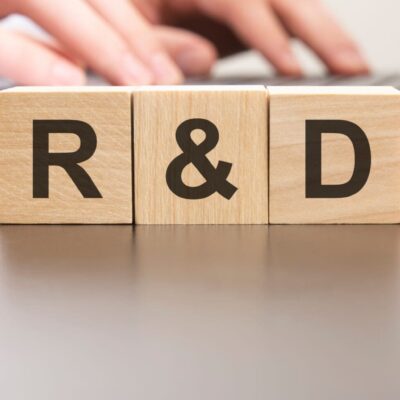Are you a small business owner looking to take advantage of the Research & Development (or R&D) tax credit? If so, you’ve probably heard the term “business components” and are knee-deep in researching this “four-part qualifications test” you’ve been reading about. We’re delving into all that and more in this blog post. So sit back, get your scrolling thumb ready, and lean in to learn all your pressing questions about the R&C tax credit in this easy-to-skim six-minute article.
As highlighted in this recent blog, the Research & Development (or R&D) tax is a United States government-sponsored tax initiative. It results in a dollar-for-dollar reduction in a company’s tax liabilities and is one of the best things American businesses can do to reduce their liability tax. The research and experimentation tax credit was essentially designed as an incentive to make research activities more affordable for businesses, strengthening American innovation.
What is a Business Component?
A business component is any of the following that is for sale, lease, license, or used in trade:
Product
A product is what you make or sell for profit. So, for example, if you own a small manufacturing business that produces pre-packaged snack foods, any new foods you test and make would count as a business component. Of note: Products don’t necessarily need to be tangible. For example, if you’re an architect, your completed building design is your “product” (or business component), even if you haven’t built it.
Invention
The foundation of innovation is invention. Inventions come from research which could include carefully focused sustained inquiry and much trial and error. For example, in 2019, one company created the world’s first talking hearing aid. Suppose your small business or manufacturing company is on the verge of creating a new invention or already has a pile of recently completed creations on your shelves. In that case, you could qualify for Research & Development Tax Credits with your invention counting as a business component. As Albert Einstein put it, “Necessity is the mother of all invention.”
Process
The process is how you make your product, including the attached expenses. For instance, if you invested in new equipment for your small business, they would be counted as your qualified process improvements or business component. Although the equipment cost is most often capitalized (and not counted toward the R&D tax credit), the cost of the employees figuring it out, any materials needed for optimizing, and any third-party consultants you worked with would count as qualified research expenses or QREs.
Technique
Technique refers to the “tools” that your small business uses to follow through with your processes, from concept to completion. In manufacturing, we’re talking about the folks actively developing the molds, tools, models, and dies. The technique can also to processes with end-goals to go green, drive quality initiatives, and reduce waste.
Software
With technology advancing so rapidly, the software has to adjust accordingly. Is your small business writing custom code? If your coding project hits the mark for one of these four scenarios, you could qualify for the Research & Development Tax Credit.
- Writing code for sale, lease, or license (like us – we created custom technology-enabled tax credit filing found nowhere else)
- Writing code to infuse in your technology products.
- Writing code to run your production equipment.
- Writing code for internal uses (known in the regulations as “internal use software”)
Formula
Often, business owners tend to group all research into one general category; they don’t tend to identify specific business components separately. But for a taxpayer to claim the Research & Development tax credit, they’ll need to be able to tie individual research to a specific business component. So it’s essential to keep accurate records for claiming an R&D credit.
But what precisely should you keep track of? Read on in our next section to learn how to claim the Research & Development tax credit and what specifics you’ll want to pay close attention to.
What is the Four-Part Qualification Test?
To make things easier for small business owners, the Internal Revenue Service, or IRS, has outlined a four-part test to determine eligibility. If you can pass each component of this test and aren’t already in the middle of filing for R&D tax credits, you could be missing out on an easy way to reduce your tax liabilities.
Four-part Qualification Test:
- Qualified purposes: The purpose of research and development can include either improving or creating new business operations.
- Elimination of uncertainty: You should be able to provide proof that you’ve tried to eliminate uncertainty when improving or developing products. If you need to hire contractual research employees for this step in the process, as long as there is a possible connection from the work to your small business, these expenditures can be fully deducted.
- Process of experimentation: You’ll want to be sure that you can affirm the methods of the process. For instance, this can include simulation or trial and error. Generally, some of these processes tend to have engineering and computer software development.
- Technological in nature: Your R&D project should relate to the hard science field. This could include physics, engineering, chemistry, biology, or biological sciences.
Does My Business Component Pass the Four-Part R&D Qualification Test?
So you have a business component that matches, you’ve checked the Four-Part Qualifications and started gathering your qualifying documents. What’s next? Now is the perfect time to reach out to a team of tax specialists. We guarantee that your experience will be professional, timely, and compliance-driven, saving you time, money, and resources.
Still not sure? Let’s run through a quick example of how a few companies could pass the Four-Part R&D Qualification Test and qualify for the credit:
Let’s say you’re in charge of a manufacturing firm developing medical devices. You want to increase productivity from 12 percent to 17 percent and are looking for ways to make this goal happen.
The following activities could qualify you for the R&D credit:
- Qualified purposes: Research and development aim to improve business operations from 12 to 17 percent.
- Elimination of uncertainty: By hiring contractual research employees for this specific project and using their suggested processes, this manufacturing company can prove that they’ve tried to eliminate uncertainty when improving production. This could include considering new molds and cost evaluations for evaluating the raw materials.
- Process of experimentation: For this manufacturing company, they can affirm the methods of the process with software development. They work to create software specifically for increasing production levels and determine factors for raw material proper heating and cooling temperatures.
- Technological in nature: This R&D project is related to the hard science field through biological sciences.
Similarly, suppose you have a product run by software. In that case, the costs of developing new software to make that product more efficient or reliable may qualify you for the Research & Development tax credit. Or, if you’re an engineering firm, the costs attached to researching and establishing green technology could qualify.
Many projects could qualify you; Save up to $250,000 for your small business from research and development. Maximize your savings and let Stenson Tamaddon ensure that your R&D Tax Credit filing is accurate, compliance-focused, and on time – allowing you to get back to what you love doing.
How Do You Claim the R&D Tax Credit?
Is your business already performing one or more of the business components above? If so, you may be ready to start claiming the Research & Development tax credit.
First up on your to-do list? Check above for the four-part qualification test. Here is where you’ll find the specific questions you’ll need to address to decide if you’re eligible to claim the credit.
If you pass the four-part qualification test, you’re ready to gather your documents. These could include:
- Chart of accounts
- Employee form W-2s
- Payroll registers
- Invoices
- Receipts
- General ledger
- Meeting minutes
- Service contracts
- Form 1099-NEC (for individual contractors)
Specifically, you’ll want to retain all records that correlate with each specific R&D project, ensuring that all calculations of the credit eligibility are in order.
Next up? Check below for the best way to file for the Research & Development tax credit.
Who Can Help My Business File for the R&D Credit?
Stenson Tamaddon works with business owners to leverage the benefits of government stimulus programs like the R&D Tax Credit.
We believe in a professional, compliant approach to tax credit services and provide a hassle-free promise to customers that their R&D Tax Credit filing will always be accurate, compliance-driven, and secure. Our team uses proprietary technology to deliver services that are second to none while fully maximizing your filings. With offices from New York to Arizona, we exist to provide optimal results for your R&D Tax Credit filing with minimal disruption to your business.
Don’t wait to file for the Research and Development Tax Credit. In as few as these three steps, we’ll help you retrieve the money you deserve:
- Fill out a quick 7-question form to start your application.
- Use our proprietary technology to securely upload all relevant documents and information to our tax credit team.
- We’ll take your information, prepare it and submit it for filing with the IRS with our 100% secure and compliance-driven technology.
Get the money you deserve. We’re ready to help you identify what federal stimulus funding may be available for your business. So get started with an R&D tax credit specialist today.






